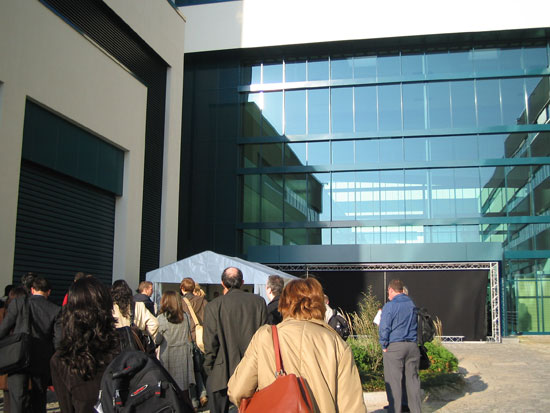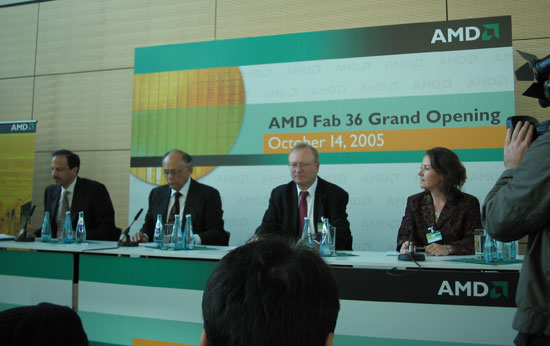AMD's Fab 36 Grand Opening - 90nm and 300mm in Germany
by Anand Lal Shimpi on October 14, 2005 7:50 AM EST- Posted in
- CPUs
After 24 months of construction, today AMD's first 300mm semiconductor fab, Fab 36, celebrates its grand opening. Built adjacent to AMD's 200mm Fab 30 in Dresden, Germany, Fab 36's grand opening takes place 6 years after Fab 30's introduction. The name Fab 36 comes from its existence 36 years after the founding of AMD.
The announcement for Fab 36's site in Dresden came in November 2003, with first ground breaking at the end of that month. Approximately 12 months later, the building was ready for equipment, and another 12 months after that, Fab 36 began preparations for mass production.

Over 150 members of the press enter AMD's press conference at Fab 36 in Dresden
Unfortunately, at its grand opening, Fab 36 is still a 90nm-only fab; throughout the next year, AMD will begin the transition to 65nm production. The first CPUs built at Fab 36 will be shipping in the first quarter of 2006, with the first 65nm chips leaving Fab 36 by the end of 2006.
Sometime in 2007 AMD will have performed a "substantial amount" of the transition of Fab 36 to a 65nm semiconductor fab, bringing the grand total for the cost of Fab 36 to an astounding 2.5 billion US dollars. There is no word when Fab 36 will be completely converted to 65nm manufacturing.
By 2008, Fab 36 will be able to produce more than 2x the number of processors as Fab 30 (potentially 100M processors per year based on current die sizes).
The first 300mm wafer produced at Fab 36 actually took place back in March, but preparation for mass production continues up to and beyond today. Today's grand opening of Fab 36 marks a huge step in AMD history, as it will hopefully alleviate a number of the supply issues they have been plagued with in recent history.

The two individuals in the middle kicked off the day at Fab 36, AMD's CEO, Dr. Hector Ruiz is the second on the left, and VP/GM of AMD Dresden, Dr. Hans Deppe is to the right of Dr. Ruiz.
The day started off with a press conference kicking off the grand opening of the fab. Below we've got a picture of a clean room engineer (or someone dressed as one) posing with AMD's Dr. Hans Deppe, the Corporate VP and General Manager of AMD in Dresden.

While we don't have a 200mm wafer here to compare sizes with, imagine the wafer pictured above, but smaller.
After some brief words about the opening of Fab 36, a brief Q&A period started. One of the first questions was what will happen to Fab 30 in the future now that Fab 36 is ready to start mass production. Dr. Ruiz mentioned that Fab 30 could be used for more x86 microprocessor production, it could potentially become a chipset manufacturing fab (possibly indicating AMD's intentions to eventually return to chipset manufacturing), or it could be upgraded to future semiconductor technologies for use in the future (e.g. 65nm).
One other important question that was asked was "why Dresden" for Fab 36, to which the answer was obviously multi-faceted:
1) First and foremost, AMD has invested a lot in the people of Dresden, when it comes to training and expertise in semiconductor manufacturing. It was simply easier to leverage the existing human investment.
2) Obviously government subsidies played a large role in AMD's decision to bring Fab 36 to Dresden. Dr. Hans Deppe listed the total amount of government subsidies for Fab 36 as 500 million US dollars.
The final question of the press conference was about AMD's future fab plans, which Dr. Ruiz answered with a timeframe of 2008 for the start of production on the next major fab plant.










70 Comments
View All Comments
Spoonbender - Friday, October 14, 2005 - link
Am I the only one who's a bit disappointed by that? So they're a full year behind Intel on this?MrEMan - Friday, October 14, 2005 - link
And just how many of Intel's many fabs have actually been converted, and what is their schedule for conversion. With out knowing that how can one make a judgement as to how far behind AMD is?Also, what is more preferred: better processors across the board at 90 nm or lesser processors at 65 nm. If I recall correctly the concentration of heat goes up as the die size is reduced which would portend greater heat problems for Intel, not less, at least until they redesign based on the PIII/Pentium M higher IPC/lower clock speed internal designs.
Johnmcl7 - Friday, October 14, 2005 - link
If you read the articles on Intel's new 65nm you'll see the power usage and thermal dissipation is lower than the 90nm prescotts.John
Johnmcl7 - Friday, October 14, 2005 - link
As in their 65nm netburst processors, not the next generation P-m based designs.John
coldpower27 - Friday, October 14, 2005 - link
Themral density may be increased, by overall thermal output of processors on 65nm process is reduced compared to 90nm for NetBurst at least. That is why CPU's are equipped with heatspreaders to help disappate the heat over a large surface area.As long as the processor runs stable and reliably there should be no complaints.
The slower 65nm transition at Fab 36 is expected. AMD roadmaps don't indicate any 65nm products for the first half of 2006, with Windsors, Orleans & Manilla Socket M2 based processors still at 90nm node. Hopefully we will see some 65nm products on the roadmaps for 2nd half 2006, which is around the time of Intel introduction of 2nd Generation processors on 65nm tech namely Merom/Conroe.
nserra - Friday, October 14, 2005 - link
Remember that AMD processors are not made of the same "compounds" of Intel processors.Maybe AMD could also launch a 65nm based processor based on "compounds" of Intel processors.
As
Intel could "never" launch a 65nm based processor using AMD "compounds".
smn198 - Friday, October 14, 2005 - link
Hope this means cheaper processors as AMD is able to up output, reduce margins and force Intel to do the same but where can I get one of those wafers?ariafrost - Friday, October 14, 2005 - link
My AMD stock probably will jump today ;)Questar - Friday, October 14, 2005 - link
Why would it? This is not news, this "grand opening" has already been priced into the current price. Be aware this plant is not producing any sellable chips at this point.bigpimpatl - Friday, October 14, 2005 - link
ooooh nice =)